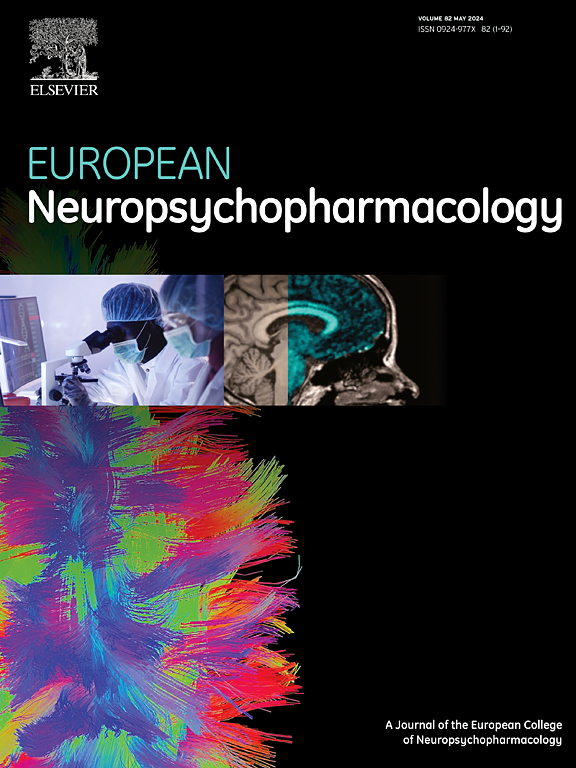A REPEATED MEASURES GWAS IN RELATIVES: DETECTING AGE-VARYING GENETIC EFFECTS ON MATERNAL DEPRESSION IN MOBA
IF 6.7
2区 医学
Q1 CLINICAL NEUROLOGY
引用次数: 0
Abstract
Background
Genome-wide association studies (GWAS) of depression typically rely on case-control analyses, using lifetime history (LTH) of a diagnosis as the primary outcome. Longitudinal cohorts provide opportunities to understand how genetic effects on depression vary across time and contexts. We aimed to harness repeated measures in a single sample to minimise phenotypic heterogeneity and improve statistical power to detect genetic effects on depression.
Methods
We used data from mothers who participated in the Norwegian Mother, Father and Child study (MoBa). We restructured the Hopkins Symptoms Checklist Depression (SCL-D) scores for 76,044 mothers by age, producing an accelerated longitudinal design with 418,159 depression observations across the lifecourse (age range: 16, 60 years old). We used continuous-time item response theory models to minimise measurement error, and Empirical Bayes Estimates with Simultaneous Correction (SCEBE) to conduct repeated measures GWAS (GWASRM). We estimated genetic effects on depression symptoms at age 30, and the linear change in age (variant by age interaction), which were combined to compute age-specific effects at ages 20 to 50 (GWASt=20..50). For comparison, we performed a GWAS of LTH depression assessed in the same sample (GWASLTH). Summary statistics from GWASRM and GWASLTH were compared using heritability and genetic correlations. We also performed 10-fold-leave-one-out GWASRM and GWASLTH, leaving 10 test datasets for polygenic index (PGI) analyses. The efficacy and robustness of SCEBE was further assessed via comparison with linear mixed effects models applied to a subset of the data. The impact of selective attrition on GWASRM is also currently under investigation.
Results
SCEBE is an efficient and robust method for estimating genetic variant main effects and variant-by-age interactions, with perfect overlap with effects estimated using a linear mixed model. Following GWASRM, there was one independently significant (p < 5e-8) locus associated with depression symptoms at age 30 and an additional locus at age 40. The SNP-based heritability (h2SNP) of GWASt ranged from 0.01 to 0.05. Following GWASLTH there was one independently significant locus associated with lifetime history of depression, and the h2SNP estimate was 0.15. The age-specific PGI (PGIt) was associated with higher SCL-D symptoms (β=4.21, 95% CI: 6.27, 2.14; p=6.68e-5). The PGILTH was also associated with SCL-D symptoms (β=3.73, 95% CI: 2.78, 4.68).
Discussion
Despite the anticipated gains in statistical power from a repeated measures approach in a homogenous sample, we did not detect substantial improvement in genome-wide signal for depression. These results might be due to etiological heterogeneity associated with depression and unobserved confounding. For example, medication status was not available across these time-points and was not included in these models. Furthermore, both initial and continued participation are associated with depression symptoms - and individuals with the greatest burden from depression are less likely to participate and more likely to drop out of studies earlier. Work is ongoing to assess the role of confounding from medication status and to adjust repeated GWASRM for selective participation and attrition.
在亲属中重复测量:检测年龄变化的遗传对moba母亲抑郁的影响
抑郁症的全基因组关联研究(GWAS)通常依赖于病例对照分析,使用诊断的终生史(LTH)作为主要结果。纵向队列研究为了解基因对抑郁症的影响如何随时间和环境而变化提供了机会。我们的目标是在单个样本中利用重复测量来最小化表型异质性,并提高检测抑郁症遗传影响的统计能力。方法我们使用参与挪威母亲、父亲和儿童研究(MoBa)的母亲的数据。我们对76044名母亲按年龄重组了霍普金斯抑郁症状检查表(SCL-D)评分,在整个生命过程中(年龄范围:16岁至60岁)进行了418159次抑郁观察的加速纵向设计。我们使用连续时间项目反应理论模型来最小化测量误差,并使用同时校正的经验贝叶斯估计(SCEBE)来进行重复测量GWAS (GWASRM)。我们估计了遗传对30岁时抑郁症状的影响,以及年龄的线性变化(年龄相互作用的变异),并将其结合起来计算20至50岁时的年龄特异性影响(GWASt=20. 50)。为了进行比较,我们对同一样本进行了LTH抑郁的GWAS评估(GWASLTH)。GWASRM和GWASLTH的汇总统计数据采用遗传力和遗传相关性进行比较。我们还进行了10倍留一GWASRM和GWASLTH,留下10个测试数据集用于多基因指数(PGI)分析。通过与应用于数据子集的线性混合效应模型的比较,进一步评估了SCEBE的有效性和稳健性。选择性磨损对GWASRM的影响目前也在研究中。结果scebe是一种有效、稳健的遗传变异主效应和年龄变异相互作用估计方法,与线性混合模型估计的效应有很好的重合。在GWASRM之后,有一个独立显著(p < 5e-8)基因座与30岁时的抑郁症状相关,另一个基因座与40岁时的抑郁症状相关。GWASt的snp遗传力(h2SNP)范围为0.01 ~ 0.05。在GWASLTH之后,有一个与抑郁终生史相关的独立显著位点,h2SNP估计为0.15。年龄特异性PGI (PGIt)与较高的scd症状相关(β=4.21, 95% CI: 6.27, 2.14; p=6.68e-5)。PGILTH也与SCL-D症状相关(β=3.73, 95% CI: 2.78, 4.68)。讨论:尽管在同质样本中重复测量方法的统计能力预期有所提高,但我们并没有发现抑郁症全基因组信号的实质性改善。这些结果可能是由于与抑郁症相关的病因异质性和未观察到的混杂。例如,这些时间点的药物状态不可用,也不包括在这些模型中。此外,最初和持续参与研究都与抑郁症状有关——抑郁负担最重的个体参与研究的可能性更小,更有可能提前退出研究。目前正在进行的工作是评估药物状态混淆的作用,并调整重复的GWASRM以选择性参与和损耗。
本文章由计算机程序翻译,如有差异,请以英文原文为准。
求助全文
约1分钟内获得全文
求助全文
来源期刊

European Neuropsychopharmacology
医学-精神病学
CiteScore
10.30
自引率
5.40%
发文量
730
审稿时长
41 days
期刊介绍:
European Neuropsychopharmacology is the official publication of the European College of Neuropsychopharmacology (ECNP). In accordance with the mission of the College, the journal focuses on clinical and basic science contributions that advance our understanding of brain function and human behaviour and enable translation into improved treatments and enhanced public health impact in psychiatry. Recent years have been characterized by exciting advances in basic knowledge and available experimental techniques in neuroscience and genomics. However, clinical translation of these findings has not been as rapid. The journal aims to narrow this gap by promoting findings that are expected to have a major impact on both our understanding of the biological bases of mental disorders and the development and improvement of treatments, ideally paving the way for prevention and recovery.
 求助内容:
求助内容: 应助结果提醒方式:
应助结果提醒方式:


